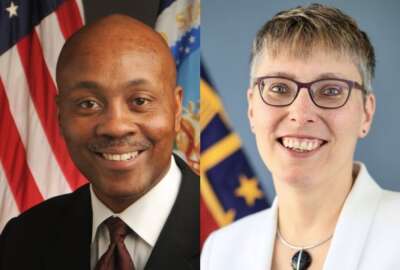USDA hasn’t kept pace in documenting Farmers.gov performance, GAO says
No one quite knows how Farmers.gov is working because USDA hasn’t followed its own rules for documenting progress on IT programs.
Three years ago, the Agriculture Department launched Farmers.gov. The new IT system was meant to deliver self-service tools to farmers and ranchers who rely on government support. USDA plans to spend almost $170 million on it by 2023. So how’s it working? No one quite knows because USDA hasn’t followed its own rules for documenting progress on IT programs. The feedback it’s gathered from farmers isn’t especially illumining either. The Government Accountability Office made 15 recommendations to improve USDA’s oversight of the program. For more, Federal News Network’s Jared Serbu spoke with the GAO’s Vijay D’Souza on Federal Drive with Tom Temin.
Interview transcript:
Vijay D’Souza: Farmers.gov is a system that USDA set up to provide services to farmers, ranchers, and other folks that receive grants and loans from USDA. And there’s two parts to it: One part is a publicly facing site that anybody can go to. So for example, if you are a farmer, or maybe want to be a farmer, you can go to this site to figure out what loans you might be eligible for. The second part of it is an authenticated site, which means you log in. And so if you get a loan or a grant from USDA, you can log in to check your status. And then as part of that USDA employees use the same system kind of on the back end to administer a lot of these loan programs.
Jared Serbu: Yeah, and as you kind of suggest, it’s much more than just a website. I think the total investment USDA has planned for this was I think he said $167 million over five years. So a big project that you would expect a lot of oversight to be associated with, as the report points out in a good amount of detail, the department has a lot of oversight mechanisms on paper that are supposed to be applied to projects like this, but they just, they skipped a lot of those steps. Can you just give us a flavor for some of the oversight mechanisms that should have been applied here according to USDA policy, and were not?
Vijay D’Souza: Sure so USDA has a series of boards that are supposed to meet review, its IT investments. And what we found, especially at the senior level, is that these boards weren’t even meeting for the last several years. So if they weren’t meeting, there’s no way they could review investments. In addition, specific to Farmers.gov, we found that a lot of the artifacts or documentation that you would need to develop in order for management and leadership to review, investment simply didn’t exist. So between those two things, it’s really hard to see how USDA could effectively oversee the program.
USDA did tell us they had a number of informal processes in place to conduct oversight. But again, with a project serving so many people across the country and handling billions of dollars, it’s really important to have more structured oversight processes in place.
Jared Serbu: The launch of this website was was really right around the time that this mission area was undergoing a pretty significant reorganization when they consolidated several of the relevant agencies into this new thing called the Farm Production and Conservation Mission Area (FPAC). Did that sort of turmoil that was going on at that point around restructuring leadership, especially in the IT area, have much to do with some of these missing oversight steps, as far as you can tell?
Vijay D’Souza: I think it definitely played a part. For example, I mentioned that some of these boards weren’t meeting. One of the boards wasn’t even founded until after this project was underway. So that’s definitely a piece of it. More separately, FPAC has a lot on its plate as far as trying to consolidate three separate agencies into one consolidated entity. So that was actually second part of our report, we looked at some of the efforts that FPAC had underway to really create a stronger IT organization for the consolidated group.
Jared Serbu: Yeah, you want to just expand on that a little bit and what you found as far as the success of that, that effort to strengthen the oversight?
Vijay D’Souza: Sure, happy to do so. So we looked at three areas, we looked at IT workforce planning, we looked at duplication and overlap or efforts to reduce IT duplication overlap, and then we looked at efforts to measure and improve customer service. With respect to all of these areas, we found that F pack had a ways to go to do what it needs to do in these areas. With respect to IT workforce planning, for example, FPAC has a significant shortage in its staff. But what we found is they hadn’t really done a formal analysis to figure out exactly how many types of IT staff in different roles needed. And then as a result of not having that you can’t really have a plan to figure out how you’re going to address all these gaps you have in your it workforce gap.
One of the things we heard tied back to farmers.gov is that USDA didn’t necessarily have a lot of staff that were familiar with the project methodology that they were using on this project. So it was harder hard for them to do oversight. With respect to duplication overlap, FPAC has a couple initiatives underway in areas such as data center duplication and moving to the cloud, but it lacks an overall strategic plan and it lacked performance measures to figure out is it – are there really tangible steps and is it achieving those steps to reduce duplication in the organization? And then with respect to customer service, interestingly enough, USDA did do a survey of Farmers.gov customers or more broadly farmers to measure their satisfaction. But they did the survey more than a year ago. And as of the time of our report, it still hadn’t released the results.
Now USDA later told us that there was a number of problems, the survey, but the intention was that this was supposed to be an annual process. And the point we made is, you need to have different customer service metrics. And then you can use the survey to see, are you meeting the mark for your customers or not? Without those processes in place, you don’t really know if you’re making the end user, the farmer, the rancher, or even the USDA employee happy with this multi-million-dollar system.
Jared Serbu: Yeah. And it seems like that’s really a big bottom line here is, A) there’s a lot of missing documentation that you would normally use to do oversight and assess the status of the program and how things are working. If you don’t have that, maybe you can ask the users how things are working. But if you don’t have that, either, it’s just really hard to say what you’re getting out of this multi-, as you said, multi-million-dollar investment. So I think your bottom line here really is we don’t really know how well Farmers.gov is performing and that in itself is kind of risky, right?
Vijay D’Souza: Yeah, I think that’s right. Another important thing to note here is that they’re continuing to add features to this program. And they have plans to do that for the next three or four years. So to figure out which improvements make sense and are these new improvements working, again, you need all this information we talked about.
Jared Serbu: And there’s a good page in the report where you have a table that just lists all of the oversight steps that we’ve been talking about, and all the documentation that’s supposed to be produced that USDA didn’t in this case. And just looking in from the outside, I gotta say it’s a it’s a pretty daunting list. And, again, as an outsider, it makes me wonder if that much oversight and that much box checking is really compatible with anything resembling agile methodology. Is there a sweet spot between those things where you actually have adequate oversight, and you can move quickly and efficiently?
Vijay D’Souza: Yeah, there definitely is. And that’s a totally fair question. And that was one of the points USDA made to us is that we’re conducting agile processes. And our original methodology that we have documented supports the older waterfall approach. But just because you’re doing agile doesn’t mean you need no documentation, you might need a different sort of documentation, you might need to have more streamlined versions of it and other things. But you can’t have no documentation, there’s no way that senior leadership can really effectively oversee these projects without having something showing key cost schedule milestones, and are you hitting them? Or are you not hitting them? GAO has an agile guide that lays out some of these challenges and some ways to handle them. And that’s part of what we use to assess USDA for this report.
Jared Serbu: So it sounds like part of this is the USDA may just need to revise its oversight processes, but they need to have processes and they need to follow them.
Vijay D’Souza: Correct. And that’s a consistent theme we see across multiple federal agencies, a lot of agencies documented IT development processes are really set up for these older waterfall approaches. And they’ve really got to revise them to reflect the newer approach. Again, agile doesn’t mean you don’t do any documentation, but maybe it means you do a different sort of documentation more tailored more directly focused on agile steps.
Jared Serbu: And so just to wrap us up, there’s a lot of recommendations here, I think he had 15 in total, we don’t have time to get into every single one of them. But beyond what we’ve covered, what are the key things that USDA needs to do kind of now to make sure that they have, that they start to get on track toward adequate oversight of this program?
Vijay D’Souza: Well, one of the things we said is to go back and take a look at what USDA said the required documentation is but then make a conscious decision. Do we still need any of this after the fact or maybe we don’t need this we’re going forward we can do these other things? So that gets to your point of thinking about whether everything is totally needed. And then for the other areas we talked about USDA does need to do things like measure whether it’s providing good customer service, and have a plan for reducing IT duplication overlap and figuring out how to fill its workforce gaps. So those summarize the key areas. USDA agreed with us on all these recommendations. And for example that board I mentioned that wasn’t meeting they said it had already started meeting since we issued our report. So that’s definitely a good sign and hopefully USDA will continue to make progress in addressing some of these issues.
Copyright © 2025 Federal News Network. All rights reserved. This website is not intended for users located within the European Economic Area.
Tom Temin is host of the Federal Drive and has been providing insight on federal technology and management issues for more than 30 years.
Follow @tteminWFED






